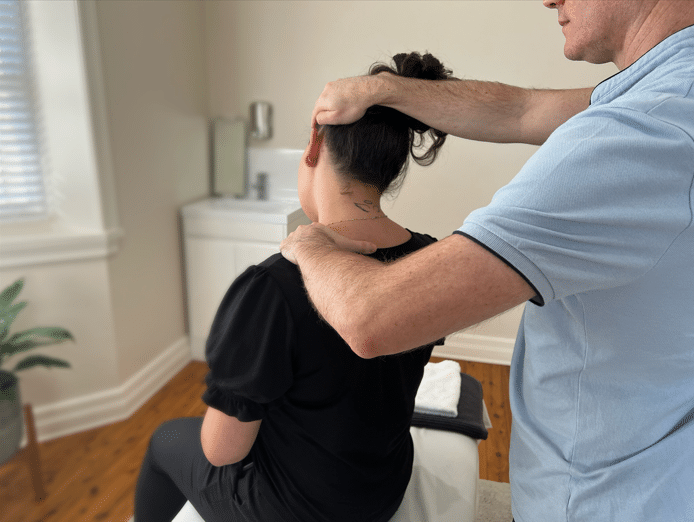- 02 9712 1736
- [email protected]
- 212 Great North Road, Five Dock, NSW 2046
- Open 7 days a week
Imagine driving home on a quiet street, stopped at an intersection, when suddenly – a thunderous crash. Your car jerks forward, then back, and in a split second, your head whips through a violent motion you never saw coming. This moment, lasting mere seconds, can transform into weeks or even months of persistent neck pain and discomfort. Welcome to the complex world of whiplash – an injury that’s far more nuanced than many realize.

At its core, whiplash is a story of structural vulnerability. Picture your neck as a sophisticated suspension bridge, designed to support weight and facilitate movement with remarkable precision. During a whiplash incident, this delicate structure experiences forces it wasn’t designed to withstand.
The injury begins with ligament overstretching – imagine rubber bands being pulled beyond their elastic limit. These supportive tissues, which normally provide stability, suddenly find themselves compromised. This overstretching triggers an immediate muscle guarding response, where muscles tense and contract to protect the suddenly unstable neck region.
This isn’t just a physical reaction but a complex neurological event. Your nervous system perceives the sudden trauma and responds by essentially “locking down” the neck muscles. It’s a protective mechanism that, while well-intentioned, can lead to prolonged discomfort and reduced mobility.
Whiplash doesn’t discriminate, but certain demographics face higher risks. Young to middle-aged adults between 20 and 50 years old are most frequently affected, with variables like occupation, lifestyle, and personal health playing significant roles. Professionals in high-risk environments – such as drivers, athletes, and those in physically demanding professions – find themselves more susceptible to this unexpected neck injury.
Women statistically report whiplash injuries more often than men, potentially due to differences in muscle mass, neck strength, and seating positions in vehicles. However, this doesn’t mean men are immune. The condition transcends gender, affecting anyone exposed to sudden, forceful neck movements.

While automobile accidents remain the most recognized cause of whiplash, the injury can emerge from surprisingly diverse scenarios. Sports provide another significant source of risk. Imagine a football tackle, a sudden collision in basketball, or an unexpected fall during skiing – each can generate the precise combination of forces needed to create a whiplash injury.
Physical traumas like amusement park rides, workplace accidents, and even vigorous recreational activities can trigger this condition. The common thread isn’t the specific activity but the unexpected, rapid acceleration and deceleration that forces the neck beyond its natural range of motion.

Chiropractic care approaches whiplash as more than just a physical injury. Practitioners view it as a comprehensive musculoskeletal challenge requiring a patient approach and a nuanced, patient-centered strategy. The goal extends beyond pain reduction to facilitating optimal recovery and preventing long-term complications by restoring proper function.

Through detailed assessments, chiropractors identify specific musculoskeletal deficits created by the injury. Manual therapy techniques are employed to gently and gradually restore joint function, reduce muscle tension and pain, and support the body’s natural healing processes, while working on improving stability in the affected level of the neck. It is important that recovery is not rushed, and the body is allowed to gradually regain optimal function.
Your chiropractor will advise you on posture, movement patterns, and specific rehabilitative exercises. Patients learn not just about healing but also about understanding their body’s responses and preventing future injuries.
Whiplash might seem like an overwhelming diagnosis, but it doesn’t have to define your health journey. Understanding its mechanisms, recognizing early signs, and seeking professional guidance can dramatically influence your recovery trajectory.
If you’ve experienced a sudden impact or are dealing with persistent neck discomfort, don’t wait. Consult with a healthcare professional who can provide a comprehensive assessment and personalized recovery strategy.
Forest Lodge, Annandale, Glebe, Leichhardt, Balmain, Haberfield, Canada Bay, Rozelle, Rodd Point, Wareemba, Stanmore, Petersham, Lilyfield, Hunters Hill, Enfield, Cabarita, Mortlake, Rhodes, Burwood Heights, Birchgrove, Gladesville, Huntleys Point, Abbotsford, Ashfield, Croydon Park, Croydon, Chiswick, Russell Lea, Burwood, Strathfield, Concord, Drummoyne, North Strathfield, Liberty Grove, Dulwich Hill, Lewisham, Camperdown, Ashbury, Homebush, Homebush West, Woolwich, Henley, Summer Hill, Sydney Olympic Park

212 Great North Road, Five Dock, NSW 2046
Onsite parking available
Phone: 02 9712 1736
Email: [email protected]

About
Five Dock Osteopathic & Chiropractic is located in Canada Bay, in Sydney’s Inner West. Servicing suburbs including Burwood, Croydon, Drummoyne, Five Dock, Haberfield, Concord, Abbotsford, Chiswick, Leichhardt, Wareemba, Russell Lea, Summer Hill, Strathfield.
Clinic hours
Monday, Tuesday, Thursday 7AM – 7PM
Wednesday, Friday 7AM – 6PM
Saturday 7AM – 2PM
Sunday 8AM – 2PM
Contact details